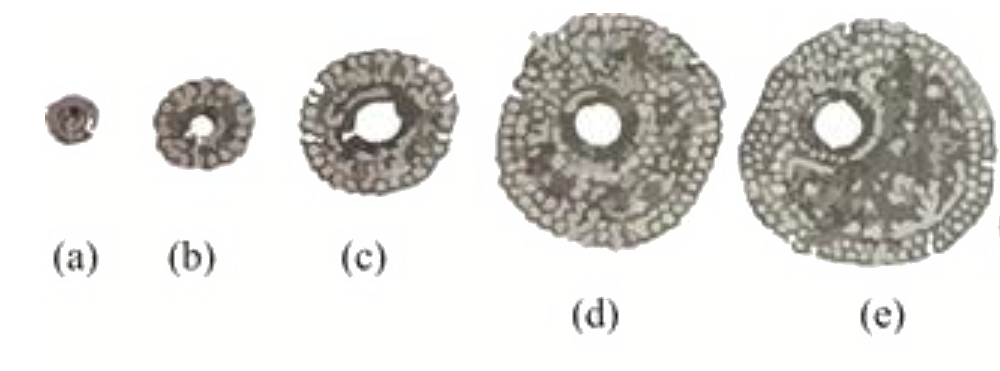a) Name the hormones secreted and write their functions:
i) by corpus luteum and placenta (any two).
ii) During Follicular phase and parturition.
b) Name the stages in a human female where:
i) Corpus luteum and placenta co-exist.
ii) Corpus luteum temporarily ceases to exist.
Step-by-Step Solution:
1. Corpus Luteum:
- Hormones Secreted:
- Progesterone
- Estradiol (a form of estrogen)
- Functions:
- Progesterone:
- Maintains the endometrium (the lining of the uterus) for implantation of the fertilized ovum.
- Inhibits the release of Follicle Stimulating Hormone (FSH) to prevent the development of additional follicles.
- Estradiol:
- Supports the maintenance of the endometrium and contributes to the regulation of the menstrual cycle.
2. Placenta:
- Hormones Secreted:
- Human Placental Lactogen (hPL)
- Human Chorionic Gonadotropin (hCG)
- Functions:
- Human Placental Lactogen (hPL):
- Modifies the metabolism of the mother to ensure an energy supply to the fetus.
- Has anti-insulin properties, which reduce maternal insulin sensitivity and increase blood glucose levels.
- Human Chorionic Gonadotropin (hCG):
- Maintains the corpus luteum during pregnancy.
- Stimulates the release of progesterone to sustain the pregnancy.
ii) During Follicular Phase and Parturition:
1. Follicular Phase:
- Hormones Secreted:
- Luteinizing Hormone (LH)
- Follicle Stimulating Hormone (FSH)
- Functions:
- LH: Stimulates ovulation and the production of estrogen from the growing follicles.
- FSH: Promotes the growth and maturation of ovarian follicles and stimulates estrogen secretion.
2. Parturition:
- Hormones Secreted:
- Oxytocin
- Functions:
- Oxytocin: Triggers contractions of the smooth muscles of the uterus (myometrium) to facilitate childbirth and directs the fetus towards the birth canal.
---
b) Name the stages in a human female where:
i) Corpus Luteum and Placenta Co-exist:
- Stage: During early pregnancy, specifically in the first trimester when the fertilized ovum has implanted in the endometrium.
ii) Corpus Luteum Temporarily Ceases to Exist:
- Stage: During menstruation, when the corpus luteum degenerates if fertilization does not occur.
---
- Hormones Secreted:
- Progesterone
- Estradiol (a form of estrogen)
- Functions:
- Progesterone:
- Maintains the endometrium (the lining of the uterus) for implantation of the fertilized ovum.
- Inhibits the release of Follicle Stimulating Hormone (FSH) to prevent the development of additional follicles.
- Estradiol:
- Supports the maintenance of the endometrium and contributes to the regulation of the menstrual cycle.
- Hormones Secreted:
- Human Placental Lactogen (hPL)
- Human Chorionic Gonadotropin (hCG)
- Functions:
- Human Placental Lactogen (hPL):
- Modifies the metabolism of the mother to ensure an energy supply to the fetus.
- Has anti-insulin properties, which reduce maternal insulin sensitivity and increase blood glucose levels.
- Human Chorionic Gonadotropin (hCG):
- Maintains the corpus luteum during pregnancy.
- Stimulates the release of progesterone to sustain the pregnancy.
- Hormones Secreted:
- Luteinizing Hormone (LH)
- Follicle Stimulating Hormone (FSH)
- Functions:
- LH: Stimulates ovulation and the production of estrogen from the growing follicles.
- FSH: Promotes the growth and maturation of ovarian follicles and stimulates estrogen secretion.
- Hormones Secreted:
- Oxytocin
- Functions:
- Oxytocin: Triggers contractions of the smooth muscles of the uterus (myometrium) to facilitate childbirth and directs the fetus towards the birth canal.
- Stage: During early pregnancy, specifically in the first trimester when the fertilized ovum has implanted in the endometrium.
- Stage: During menstruation, when the corpus luteum degenerates if fertilization does not occur.
Topper's Solved these Questions
- XII BOARDSBook:XII BOARD PREVIOUS YEAR PAPER ENGLISHChapter:XII BOARDSExercise:SECTION -E
Explore 15 Videos
- XII BOARDSBook:XII BOARD PREVIOUS YEAR PAPER ENGLISHChapter:XII BOARDSExercise:DELHI BOARD- SET-III (SECTION-B)
Explore 2 Videos
- XII BOARDSBook:XII BOARD PREVIOUS YEAR PAPER ENGLISHChapter:XII BOARDSExercise:SECTION -B
Explore 12 Videos
- SAMPLE PAPER 2019Book:XII BOARD PREVIOUS YEAR PAPER ENGLISHChapter:SAMPLE PAPER 2019Exercise:Section E Part B
Explore 3 Videos
Similar Questions
Knowledge Check
In overy we can find
(i) primary follicle , (ii) Graafina follicle
(iiii) blood vessel , (iv) corpus luteumA(i) and (ii)B(ii), (iii) and (iv)C(iii) and (iv)D(i), (ii), (iii) and (iv).
(a) Name the organ that produces sperms as well as secretes a hormone in human males. Name the hormone it secretes and write its functions.
(b) Name the parts of the human female reproductive system where fertilization occurs.
(c) Explain how the developing embryo gets nourishment inside the mother's body.
View SolutionAssertion : Estrogen level is high during the follicular phase of menstrual cycle .
Reason : During this phase corpus luteum secrete large amount of estrogen .
View Solution(a) Draw a labelled diagram of the human female reproductive system.
(b) Enumerate the events in the ovary of a human female during
(i) Follicular phase
(ii) Luteal phase of menstrual cycle.
View Solution(a) Draw a sectional view of human ovary. Label the following parts :
(i) Primary follicle.
(ii) Secondary oocyte.
(iii) Graafian follicle.
(iv) Corpus luteum.
(b) Name the hormones influencing follicular development of corpus luteum.
View SolutionWhat happens to corpus luteum in human female if the ovum is (i) fertilized, (ii) not fertilized ?
View SolutionThe following is the illustration of the sequence of ovarian events "a"
to "I" in a human female :


Identify developing follicle, mature follicles and corpus luteum.
View SolutionDraw a diagram of sectional view of human ovary and label (i) Primary follicle, (ii) Tertiary follicle, (iii) Graafian follicle and (iv) Corpus luteum.
View Solution